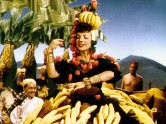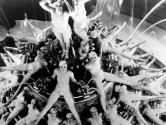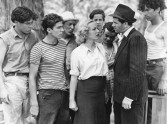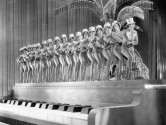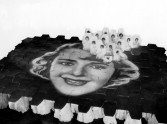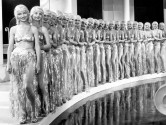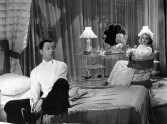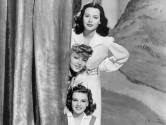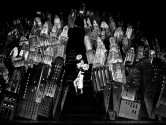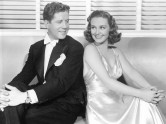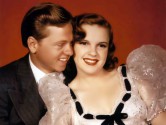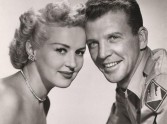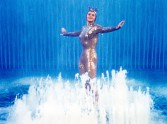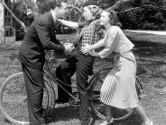
Busby Berkeley Babylon
The alliterative, musical name Busby Berkeley (1895 – 1976) is now so synonymous with a particular method of staging and filming elaborate dance numbers that—like his people-as-patterns routines—the man and his work have collapsed into a single gestalt. The Berkeley effect extended well beyond the musical and impacted all of cinema. In addition to liberating the camera, Berkeley ingeniously combined all of the extravagant, wondrous elements of the Broadway spectacular with cinema’s magical transcendence of time and space to create transportive worlds-within-worlds.
Given the names of both his parents and godparents, Busby Berkeley William Enos was born Nov. 29, 1895 to nomadic theater actors, one of whom died early; the other, his devoted mother, was loathe for her son to follow in their vaudeville footsteps. After attending a military academy, he proceeded to move up and up in the shoe business in Athol, Massachusetts. He also played semi-pro baseball, opened a dance studio, occasionally performed on stage, and crafted short theatrical numbers featuring soldiers marching in formation. The day before World War I was declared, Berkeley enlisted in the Army and quickly made a name for himself for orchestrating complex and elegant marching formations. Also working in the aerial unit for a while, he was assigned to producing entertainment for the soldiers in postwar France and, even on his trip back to the US, put on a different revue each night for the ship’s passengers.
Berkeley returned to the stage as soon as he stepped foot back in the States, at first with the Somerville Theater Stock Company as a director in the Boston area and then appearing both behind and on stage in multiple cities. After saving a fledgling theater and its failing production by staging a scandalous scene containing brief nudity, Berkeley moved as close to Broadway as possible. His first big success was as the dance director of A Connecticut Yankee,an adaptation of the Mark Twain novel to the stage. A review at the time describes one of the dance numbers as “a conglomeration of steps which combines jazz with individuality, a Charleston effect with acrobatic leaps. It is a rushing, twirling affair with a tom-tom beat, leaving the chorus breathless and the audience applauding.” As the budgets for his dance numbers grew, so did their complexity and variety of dance styles. Like James Cagney’s frantic, ingenious character in Footlight Parade, Berkeley became known as “Doctor Buzz, the Show Fixer,” working steadily on and off Broadway while still taking the occasional acting role. With 1929’s The Street Singer, he was the first to both direct and produce an entire show while designing the dance numbers—which were splashy, intricate and risqué.
Unimpressed with Hollywood musicals, Berkeley was finally urged by Eddie Cantor to direct the dances in the film version of Whoopee!, originally a Ziegfeld Broadway spectacular that bombed after the stock market crash. Once presented with the basic tools of the trade, Berkeley immediately transformed the way dance was filmed. He used just one camera with multiple angles rather than several shooting simultaneously and, in this early work, he also “introduced the big close-ups of beautiful girls”—who at that point were usually seen as legs on a stage to a theater audience—which alternated with overhead, kaleidoscopic views. Whoopee! also features a satisfying flourish that would reappear several times: the tracking shot between a row of dancers’ parted legs.
Whoopee! kicked off a string of Sam Goldwyn-produced Eddie Cantor vehicles while Berkeley bounced around the studios—as a dance director, not a choreographer—and experimented with cinematic possibilities until his extraordinary breakthrough, 42nd Street. Despite Depression losses sinking in at the studios, Darryl Zanuck and Warner Brothers were sold on the idea of “a new kind of musical” that would draw in crowds needing to escape bleak reality. At last, Berkeley was trusted with a virtually unlimited budget, and during this ambitious, audacious, fertile phase he even applied for patents for two inventions: his system of tiered, rotating platforms and his “monorail,” a rigging that smoothed and simplified camera movement.
In addition to the freedoms of Pre-Code cinema, Berkeley also benefitted from the popular device of the “backstage structure,” which let the musical numbers exist entirely outside of the film’s narrative, allowing Berkeley to create his own utopias, liberated from the constraints of plot or even physical reality. Whereas the plot often revolved around Broadway actors trying to make ends meet, the staged musical sequences detailed unbelievably ornate, erotic, dreamy, luxurious scenes within unreal contexts that frequently veered into pure design.
Berkeley’s dancing camera, dramatic angles and clever editing led his audience unwittingly through the highs and lows of comedy, drama and romance, while moving up and down from expansive, breathtaking views to intimate, commonplace vignettes. He tickled the senses with distorted, ever-changing perspective and scale; inconceivable repetition into infinity; and outrageous costumes—usually on beautiful women. Above all, he mesmerized with the synchronized, precision dancing essential to any Berkeley number. Inherited from both the military and the chorus line, these exquisitely coordinated configurations seemed a fitting expression of the dawn of both mass production and fascist standardization, representing the individual within the machine and order within a chaotic world. Finally, his camera would sweep above to view these arrangements from the heavens as abstract, hypnogogic patterns.
With each shot out-spectacularizing the preceding one, a Berkeley sequence builds up to a startling crescendo of pleasure. When this visual amazement and hypnosis mixes with a catchy song and sweet romance, the effect is beyond exhilarating. Meanwhile, Berkeley brings in his returning cast of loveable contract players like Dick Powell, Joan Blondell, Ruby Keeler, Ginger Rogers, Guy Kibbee, Ruth Donnelly, Hugh Herbert and Frank McHugh, often reappearing in similar roles—a reassuring familiarity grounding the fantastic and unearthly. Usually capped with a feel-good patriotic message, this cinema provided a satisfying release and the ultimate escape.
By the mid-thirties, Berkeley was directing full features of both the musical and non-musical variety, and if he were in any way attached to a project, his name would easily overshadow the actual director’s. His superstar status earned him a permanent place in the society pages, whether for his highly publicized system of auditioning leggy ladies for his films, his multiple marriages and their attached dramas, his extreme mother devotion or his excessive relationship with the bottle. It was at this moment—Berkeley’s most creative and most popular—that tragedy struck. One evening after a cocktail party and a tire blow-out, Berkeley crashed his car, killing three people. The whole dubious incident cost him a couple of Academy Awards for Gold Diggers of 1935 and a credit on The Singing Kid (1936), but after a year of trials he was eventually acquitted, and the studios worked strenuously to sweep the affair under the red carpet.
The subsequent change in Berkeley as well as the public’s perception of him coincided with the inevitable transformation of the musical into the more “naturalistic” format, with songs being incorporated into the narrative rather than compartmentalized. Still busily directing comedies, dramas and musicals—in part or in full—a more muted Berkeley had emerged from the wreckage. During this personally and culturally transitory time, he was originally slated to handle all the dance numbers in Wizard of Oz, yet he only directed the “If I Only Had a Brain” sequence—and even that was greatly edited down. Finally, MGM and producer Arthur Freed teamed up Berkeley with wholesome adolescent stars Mickey Rooney and Judy Garland, returning the director to his beloved backstage format, updated a bit with more narrative coherence. After directing a handful of delightful dance numbers in films like Ziegfeld Girl and Lady, Be Good, he was removed from Girl Crazy (1943) due to his purported overspending and clashes with Garland. He then travelled over to Fox to direct his magnum opus of sorts, The Gang’s All Here, which allowed him to scale back plot and engage in pure visual delight. He was even inspired to construct a mirrored, kaleidoscopic contraption that sent the film’s outrageous finale into a hypnotic wonderland. This would be his last fully Berkleyesque spectacular.
As problems with alcoholism, illness, temperament and the unpredictable whims of Hollywood mounted, Berkeley was facing diminishing offers and mounting debt. The devastating loss of his mother was the final straw leading to Berkeley’s unsuccessful suicide attempt and subsequent stay in a sanatorium. He emerged from the darkness to helm Take Me Out to the Ball Game and would direct swimming star Esther Williams in a series of aquatic films, yet Take Me Out would be the last one for which he was the sole director. By the 60s, aside from directing a few numbers in the mixed-up circus picture Jumbo, Berkeley had essentially retired from Hollywood. Toward the end of his life, he enjoyed a return to the limelight at many ceremonies and tributes during the rediscovery and appreciation of 1930s musicals.
Today’s cinema owes much to Berkeley’s many innovations and overall synthesis of the Broadway showstopper with the powers of the motion picture. He flourished in the musical—a particularly capricious genre that allows for unexplained, unnatural deviations from realism—and was at his height during a time when American audiences wanted to be delighted, astonished and thrilled. Transcending period and place, Berkeley’s classic numbers have acquired a universal appeal; they are epic, giddy, erotic, intimate, soaring—much like being in love.
A disturbing aspect of Berkeley’s cinema and other Broadway/Hollywood fare throughout the 20th century is the recurrent reliance upon blackface numbers and other racial stereotyping by white actors. Expressions of appreciation, prejudice and guilt, these demeaning imitations jolt contemporary audiences out of dreamland. They now serve as historical reminders of a society out of balance, an indicator of the inequality and injustice festering just offscreen. Rather than not screen certain works and pretend such phenomena did not happen, the HFA encourages analyses and discussion of troubling racist or sexist events in cinema and in this case, will offer speakers and introductions to provide historical context and initiate thoughtful, productive conversation.
The Harvard Film Archive presents an extensive retrospective that delves deeply into the audacious Babylon of Busby Berkeley. – Brittany Gravely

